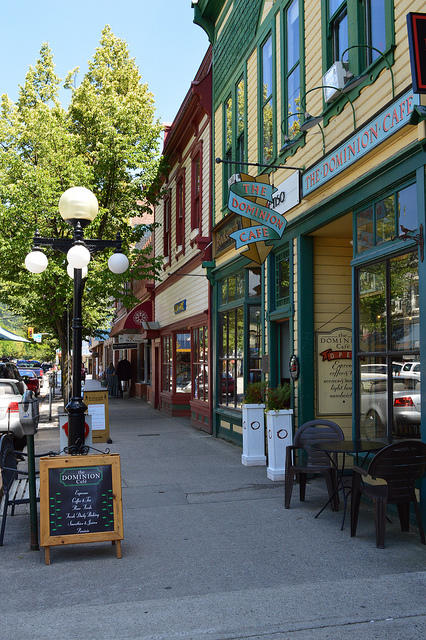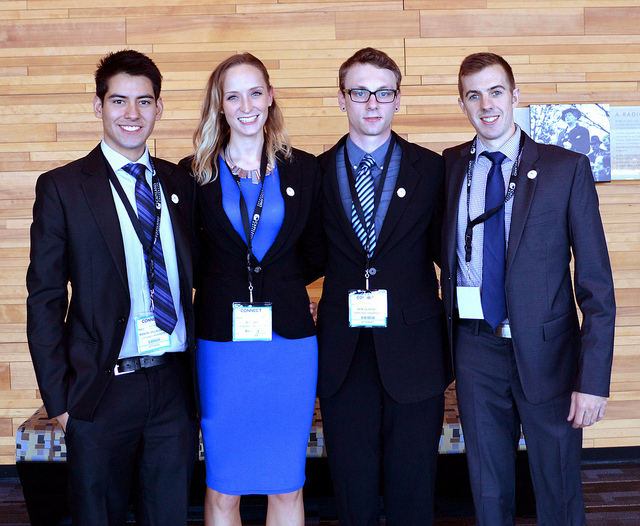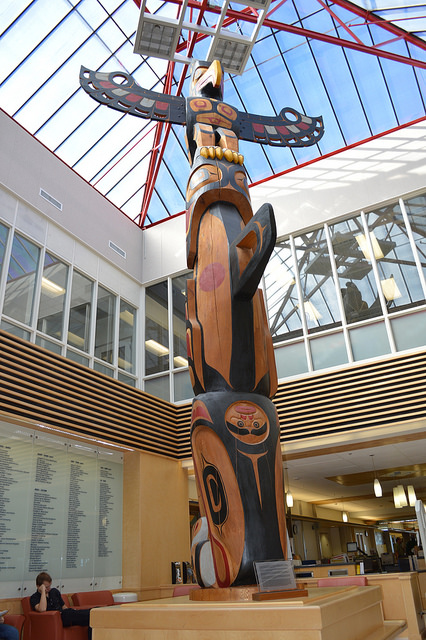Chapter 1. History and Overview
Learning Objectives
- Specify the commonly understood definitions of tourism and tourist
- Classify tourism into distinct industry groups using North American Industry Classification Standards (NAICS)
- Define hospitality
- Gain knowledge about the origins of the tourism industry
- Provide an overview of the economic, social, and environmental impacts of tourism worldwide
- Understand the history of tourism development in Canada and British Columbia
- Analyze the value of tourism in Canada and British Columbia
- Identify key industry associations and understand their mandates
What Is Tourism?
Before engaging in a study of tourism, let’s have a closer look at what this term means.
Definition of Tourism
There are a number of ways tourism can be defined, and for this reason, the United Nations World Tourism Organization (UNWTO) embarked on a project from 2005 to 2007 to create a common glossary of terms for tourism. It defines tourism as follows:
Tourism is a social, cultural and economic phenomenon which entails the movement of people to countries or places outside their usual environment for personal or business/professional purposes. These people are called visitors (which may be either tourists or excursionists; residents or non-residents) and tourism has to do with their activities, some of which imply tourism expenditure (United Nations World Tourism Organization, 2008).
Using this definition, we can see that tourism is the movement of people for a number of purposes (whether business or pleasure).
Definition of Tourist
Building on the definition of tourism, a commonly accepted description of a tourist is “someone who travels at least 80 km from his or her home for at least 24 hours, for business or leisure or other reasons” (LinkBC, 2008, p.8). The United Nations World Tourism Organization (1995) helps us break down this definition further by stating tourists can be:
- Domestic (residents of a given country travelling only within that country)
- Inbound (non-residents travelling in a given country)
- Outbound (residents of one country travelling in another country)
The scope of tourism, therefore, is broad and encompasses a number of activities.
Spotlight On: United Nations World Tourism Organization (UNWTO)
UNWTO is the United Nations agency responsible “for the promotion of responsible, sustainable and universally accessible tourism” (UNWTO, 2014b). Its membership includes 156 countries and over 400 affiliates such as private companies and non-governmental organizations. It promotes tourism as a way of developing communities while encouraging ethical behaviour to mitigate negative impacts. For more information, visit the UNWTO website: http://www2.unwto.org/.
NAICS: The North American Industry Classification System
Given the sheer size of the tourism industry, it can be helpful to break it down into broad industry groups using a common classification system. The North American Industry Classification System (NAICS) was jointly created by the Canadian, US, and Mexican governments to ensure common analysis across all three countries (British Columbia Ministry of Jobs, Tourism and Skills Training, 2013a). The tourism-related groupings created using NAICS are (in alphabetical order):
- Accommodation
- Food and beverage services (commonly known as “F & B”)
- Recreation and entertainment
- Transportation
- Travel services
These industry groups are based on the similarity of the “labour processes and inputs” used for each (Government of Canada, 2013). For instance, the types of employees and resources required to run an accommodation business — whether it be a hotel, motel, or even a campground — are quite similar. All these businesses need staff to check in guests, provide housekeeping, employ maintenance workers, and provide a place for people to sleep. As such, they can be grouped together under the heading of accommodation. The same is true of the other four groupings, and the rest of this text explores these industry groups, and other aspects of tourism, in more detail.

The Hospitality Industry
When looking at tourism it’s important to consider the term hospitality. Some define hospitality as “the business of helping people to feel welcome and relaxed and to enjoy themselves” (Discover Hospitality, 2015, ¶ 3). Simply put, the hospitality industry is the combination of the accommodation and food and beverage groupings, collectively making up the largest segment of the industry. You’ll learn more about accommodations and F & B in Chapter 3 and Chapter 4, respectively.
Before we seek to understand the five industry groupings in more detail, it’s important to have an overview of the history and impacts of tourism to date.
Global Overview
Origins of Tourism
Travel for leisure purposes has evolved from an experience reserved for very few people into something enjoyed by many. Historically, the ability to travel was reserved for royalty and the upper classes. From ancient Roman times through to the 17th century, young men of high standing were encouraged to travel through Europe on a “grand tour” (Chaney, 2000). Through the Middle Ages, many societies encouraged the practice of religious pilgrimage, as reflected in Chaucer’s Canterbury Tales and other literature.
The word hospitality predates the use of the word tourism, and first appeared in the 14th century. It is derived from the Latin hospes, which encompasses the words guest, host, and foreigner (Latdict, 2014). The word tourist appeared in print much later, in 1772 (Griffiths and Griffiths, 1772). William Theobald suggests that the word tour comes from Greek and Latin words for circle and turn, and that tourism and tourist represent the activities of circling away from home, and then returning (Theobald, 1998).
Tourism Becomes Business
Cox & Kings, the first known travel agency, was founded in 1758 when Richard Cox became official travel agent of the British Royal Armed Forces (Cox & Kings, 2014). Almost 100 years later, in June 1841, Thomas Cook opened the first leisure travel agency, designed to help Britons improve their lives by seeing the world and participating in the temperance movement. In 1845, he ran his first commercial packaged tour, complete with cost-effective railway tickets and a printed guide (Thomas Cook, 2014).
The continued popularity of rail travel and the emergence of the automobile presented additional milestones in the development of tourism. In fact, a long journey taken by Karl Benz’s wife in 1886 served to kick off interest in auto travel and helped to publicize his budding car company, which would one day become Mercedes Benz (Auer, 2006). We take a closer look at the importance of car travel later this chapter, and of transportation to the tourism industry in Chapter 2.
Fast forward to 1952 with the first commercial air flights from London, England, to Johannesburg, South Africa, and Colombo, Sri Lanka (Flightglobal, 2002) and the dawn of the jet age, which many herald as the start of the modern tourism industry. The 1950s also saw the creation of Club Méditérannée (Gyr, 2010) and similar club holiday destinations, the precursor of today’s all-inclusive resorts.
The decade that followed is considered to have been a significant period in tourism development, as more travel companies came onto the scene, increasing competition for customers and moving toward “mass tourism, introducing new destinations and modes of holidaying” (Gyr, 2010, p. 32).
Industry growth has been interrupted at several key points in history, including World War I, the Great Depression, and World War II. At the start of this century, global events thrust international travel into decline including the September 11, 2001, attack on the World Trade Center in New York City (known as 9/11), the war in Iraq, perceived threat of future terrorist attacks, and health scares including SARS, BSE (bovine spongiform encephalopathy), and West Nile virus (Government of Canada, 2006).
At the same time, the industry began a massive technological shift as increased internet use revolutionized travel services. Through the 2000s, online travel bookings grew exponentially, and by 2014 global leader Expedia had expanded to include brands such as Hotels.com, the Hotwire Group, trivago, and Expedia CruiseShip Centers, earning revenues of over $4.7 million (Expedia Inc., 2013).
A more in-depth exploration of the impact of the online marketplace, and other trends in global tourism, is provided in Chapter 14. But as you can already see, the impacts of the global tourism industry today are impressive and far reaching. Let’s have a closer look at some of these outcomes.
Tourism Impacts
Tourism impacts can be grouped into three main categories: economic, social, and environmental. These impacts are analyzed using data gathered by businesses, governments, and industry organizations.
Economic Impacts
According to a UNWTO report, in 2011, “international tourism receipts exceeded US$1 trillion for the first time” (UNWTO, 2012). UNWTO Secretary-General Taleb Rifai stated this excess of $1 trillion was especially important news given the global economic crisis of 2008, as tourism could help rebuild still-struggling economies, because it is a key export and labour intensive (UNWTO, 2012).

Tourism around the world is now worth over $1 trillion annually, and it’s a growing industry almost everywhere. Regions with the highest growth in terms of tourism dollars earned are the Americas, Europe, Asia and the Pacific, and Africa. Only the Middle East posted negative growth at the time of the report (UNWTO, 2012).
While North and South America are growing the fastest, Europe continues to lead the way in terms of overall percentage of dollars earned (UNWTO, 2012):
- Europe (45%)
- Asia and the Pacific (28%)
- North and South America (19%)
- Middle East (4%)
Global industry growth and high receipts are expected to continue. In its August 2014 expenditure barometer, the UNWTO found worldwide visitation had increased by 22 million people in the first half of the year over the previous year, to reach 517 million visits (UNWTO, 2014a). As well, the UNWTO’s Tourism 2020 Vision predicts that international arrivals will reach nearly 1.6 billion by 2020. Read more about the Tourism 2020 Vision: http://www.e-unwto.org/doi/abs/10.18111/9789284403394
Social Impacts

In addition to the economic benefits of tourism development, positive social impacts include an increase in amenities (e.g., parks, recreation facilities), investment in arts and culture, celebration of First Nations people, and community pride. When developed conscientiously, tourism can, and does, contribute to a positive quality of life for residents.
However, as identified by the United Nations Environment Programme (UNEP, 2003a), negative social impacts of tourism can include:
- Change or loss of indigenous identity and values
- Culture clashes
- Physical causes of social stress (increased demand for resources)
- Ethical issues (such as an increase in sex tourism or the exploitation of child workers)
Some of these issues are explored in further detail in Chapter 12, which examines the development of Aboriginal tourism in British Columbia.
Environmental Impacts
Tourism relies on, and greatly impacts, the natural environment in which it operates. Even though many areas of the world are conserved in the form of parks and protected areas, tourism development can have severe negative impacts. According to UNEP (2003b), these can include:
- Depletion of natural resources (water, forests, etc.)
- Pollution (air pollution, noise, sewage, waste and littering)
- Physical impacts (construction activities, marina development, trampling, loss of biodiversity)
The environmental impacts of tourism can reach outside local areas and have an effect on the global ecosystem. One example is increased air travel, which is a major contributor to climate change. Chapter 10 looks at the environmental impacts of tourism in more detail.
Whether positive or negative, tourism is a force for change around the world, and the industry is transforming at a staggering rate. But before we delve deeper into our understanding of tourism, let’s take a look at the development of the sector in our own backyard.
Canada Overview
Origins of Tourism in Canada
Tourism has long been a source of economic development for our country. Some argue that as early as 1534 the explorers of the day, such as Jacques Cartier, were Canada’s first tourists (Dawson, 2004), but most agree the major developments in Canada’s tourism industry followed milestones in the transportation sector: by rail, by car, and eventually, in the skies.
Railway Travel: The Ties That Bind

The dawn of the railway age in Canada came midway through the 19th century. The first railway was launched in 1836 (Library and Archives Canada, n.d.), and by the onset of World War I in 1914, four railways dominated the Canadian landscape: Canadian Pacific Railway (CPR), Canadian Northern Railway (CNOR), the Grand Trunk Railway (GTR), and the Grand Trunk Pacific (GTP). Unfortunately, their rapid expansion soon brought the last three into near bankruptcy (Library and Archives Canada, n.d.).
In 1923, these three rail companies were amalgamated into the Canadian National Railway (CNR), and together with the CPR, these trans-continentals dominated the Canadian travel landscape until other forms of transportation became more popular. In 1978, with declining interest in rail travel, the CPR and CNR were forced to combine their passenger services to form VIA Rail (Library and Archives Canada, n.d.).
The Rise of the Automobile
The rising popularity of car travel was partially to blame for the decline in rail travel, although it took time to develop. When the first cross-country road trip took place in 1912, there were only 16 kilometres of paved road across Canada (MacEachern, 2012). Cars were initially considered a nuisance, and the National Parks Branch banned entry to automobiles, but later slowly began to embrace them. By the 1930s, some parks, such as Cape Breton Highlands National Park, were actually created to provide visitors with scenic drives (MacEachern, 2012).
It would take decades before a coast-to-coast highway was created, with the Trans-Canada Highway officially opening in Revelstoke in 1962. When it was fully completed in 1970, it was the longest national highway in the world, spanning one-fifth of the globe (MacEachern, 2012).
Early Tourism Promotion
As early as 1892, enterprising Canadians like the Brewsters became the country’s first tour operators, leading guests through areas such as Banff National Park (Brewster Travel Canada, 2014). Communities across Canada developed their own marketing strategies as transportation development took hold. For instance, the town of Maisonneuve in Quebec launched a campaign from 1907 to 1915 calling itself “Le Pittsburg du Canada.” And by 1935 Quebec was spending $250,000 promoting tourism, with Ontario, New Brunswick, and Nova Scotia also enjoying established provincial tourism bureaus (Dawson, 2004).
National Airlines
Our national airline, Air Canada, was formed in 1937 as Trans-Canada Air Lines. In many ways, Air Canada was a world leader in passenger aviation, introducing the world’s first computerized reservations system in 1963 (Globe and Mail, 2014). Through the 1950s and 1960s, reduced airfares saw increased mass travel. Competitors including Canadian Pacific (which became Canadian Airlines in 1987) began to launch international flights during this time to Australia, Japan, and South America (Canadian Geographic, 2000). By 2000, Air Canada was facing financial peril and forced to restructure. A numbered company, owned in part by Air Canada, purchased 82% of Canadian Airline’s shares, with the result of Air Canada becoming the country’s only national airline (Canadian Geographic, 2000).
Parks and Protected Areas
A look at the evolution of tourism in Canada would be incomplete without a quick study of our national parks and protected areas. The official conserving of our natural spaces began around the same time as the railway boom, and in 1885 Banff was established as Canada’s first national park. By 1911, the Dominion Forest Reserves and Parks Act created the Dominion Parks Branch, the first of its kind in the world (Shoalts, 2011).
The systemic conservation and celebration of Canada’s parks over the next century would help shape Canada’s identity, both at home and abroad. Through the 1930s, conservation officers and interpreters were hired to enhance visitor experiences. By 1970, the National Park System Plan divided Canada into 39 regions, with the goal of preserving each distinct ecosystem for future generations. In 1987, the country’s first national marine park was established in Ontario, and in the 20 years that followed, 10 new national parks and marine conservation areas were created (Shoalts, 2011).
The role of parks and protected areas in tourism is explored in greater detail in Chapter 5 (recreation) and Chapter 10 (environmental stewardship).
Global Shock and Industry Decline
As with the global industry, Canada’s tourism industry was impacted by world events such as the Great Depression and the World Wars.
More recently, global events such as 9/11, the SARS outbreak, and the war in Iraq took their toll on tourism receipts. Worldwide arrivals to Canada dropped 1% to 694 million in 2003, after three years of stagnant growth. In 2005, spending reached $61.4 billion with domestic travel accounting for 71% (Government of Canada, 2006).
Tourism in Canada Today
In 2011, tourism created $78.8 billion in total economic activity and 603,400 jobs. Tourism accounted for more of Canada’s gross domestic product (GDP) than agriculture, forestry, and fisheries combined (Tourism Industry Association of Canada, 2014).
Spotlight On: The Tourism Industry Association of Canada (TIAC)
Founded in 1930 and based in Ottawa, the Tourism Industry Association of Canada (TIAC) is the national private-sector advocate for the industry. Its goal is to support policies and programs that help the industry grow, while representing over 400 members including airports, concert halls, festivals and events, travel services providers, and businesses of all sizes. For more information, visit the Tourism Industry Association of Canada’s website: http://tiac.travel/About.html
Unfortunately, while overall receipts from tourism appear healthy, and globally the industry is growing, according to a recent report, Canada’s historic reliance on the US market (which traditionally accounts for 75% of our market) is troubling. Because three out of every four international visitors to Canada originates in the United States, the 55% decline in that market since 2000 is being very strongly felt here. Many feel the decline in American visitors to Canada can be attributed to tighter passport and border regulations, the economic downturn (including the 2008 global economic crisis), and a stronger Canadian dollar (TIAC, 2014).
Despite disappointing numbers from the United States, Canada continues to see strong visitation from the United Kingdom, France, Germany, Australia, and China. In 2011, we welcomed 3,180,262 tourists from our top 15 inbound countries (excluding the United States). Canadians travelling domestically accounted for 80% of tourism revenues in the country, and TIAC suggested that a focus on rebounding US visitation would help grow the industry (TIAC, 2014).
Spotlight On: The Canadian Tourism Commission
Housed in Vancouver, Destination Canada, previously the Canadian Tourism Commission (CTC), is responsible for promoting Canada in several foreign markets: Australia, Brazil, China, France, Germany, India, Japan, Mexico, South Korea, the United Kingdom, and the United States. It works with private companies, travel services providers, meeting professionals, and government organizations to help leverage Canada’s tourism brand, Canada. Keep Exploring. It also conducts research and has a significant image library (Canadian Tourism Commission, 2014). For more information, visit Destination Canada website: http://en.destinationcanada.com/about-ctc.
As organizations like TIAC work to confront barriers to travel, the Canadian Tourism Commission (CTC) is active abroad, encouraging more visitors to explore our country. In Chapter 8, we’ll delve more into the challenges and triumphs of selling tourism at home and abroad.
The great news for British Columbia is that once in Canada, most international visitors tend to remain in the province they landed in, and BC is one of three provinces that receives the bulk of this traffic (TIAC, 2012). In fact, BC’s tourism industry is one of the healthiest in Canada today. Let’s have a look at how our provincial industry was established and where it stands now.
British Columbia Overview
Origins of Tourism in BC
As with the history of tourism in Canada, it’s often stated that the first tourists to BC were explorers. In 1778, Captain James Cook touched down on Vancouver Island, followed by James Douglas in 1842, a British agent who had been sent to find new headquarters for the Hudson’s Bay Company, ultimately choosing Victoria. Through the 1860s, BC’s gold rush attracted prospectors from around the world, with towns and economies springing up along the trail (PricewaterhouseCoopers, 2009).
Railway Travel: Full Steam Ahead!
The development of BC’s tourism industry began in earnest in the late 1800s when the CPR built accommodation properties along itsnewly completed trans-Canada route, capturing revenues from overnight stays to help alleviate their increasing corporate debt. Following the 1886 construction of small lodges at stops in Field, Rogers Pass, and Fraser Canyon, the CPR opened the Hotel Vancouver in May 1887 (Dawson, 2004).
As opposed to Atlantic Canada, where tourism promotion centred around attracting hunters and fishermen for a temporary infusion of cash, in British Columbia tourism was seen as a way to lure farmers and settlers to stay in the new province. Industry associations began to form quickly: the Tourist Association of Victoria (TAV) in February 1902, and the Vancouver Tourist Association in June of the same year (Dawson, 2004).
Many of the campaigns struck by these and other organizations between 1890 and 1930 centred on the province’s natural assets, as people sought to escape modern convenience and enjoy the environment. A collaborative group called the Pacific Northwest Travel Association (BC, Washington, and Oregon) promoted “The Pacific Northwest: The World’s Greatest Out of Doors,” calling BC “The Switzerland of North America.” Promotions like these seemed to have had an effect: in 1928, over 370,000 tourists visited Victoria, spending over $3.5 million (Dawson, 2004).
The Great Depression and World War II
As the world’s economy was sent into peril during the Great Depression in the 1930s, tourism was seen as an economic solution. A newly renamed Greater Victoria Publicity Bureau touted a “100 for 1” multiplier effect of tourism spending, with visitor revenues accounting for around 13.5% of BC’s income in 1930. By 1935, an organization known as the TTDA (Tourist Trade Development Association of Victoria and Vancouver Island) looked to create a more stable industry through strategies to increase visitors’ length of stay (Dawson, 2004).
In 1937, the provincial Bureau of Industrial and Tourist Development (BITD) was formed through special legislation with a goal of increasing tourist traffic. By 1938, the organization changed its name to the British Columbia Government Travel Bureau (BCGTB) and was granted a budget increase to $105,000. This was soon followed by an expansion of the BC Tourist Council designed to solicit input from across the province. And in 1939, Vancouver welcomed the King and Queen of England and celebrated the opening of the Lions Gate Bridge, activities that reportedly bolstered tourism numbers (Dawson, 2004).
The December 1941 Japanese attack on Pearl Harbor in Hawaii had negative repercussions for tourism on the Pacific Rim and was responsible for an era of decreased visitation to British Columbia, despite attempts by some to market the region as exciting. From 1939 to 1943, US visits to Vancouver (measured at the border) dropped from over 307,000 to approximately 183,600. Just two years later, however, that number jumped to 369,250, the result of campaigns like the 1943 initiative aimed at Americans that marketed BC as “comrades in war” (Dawson, 2004).
Post-War Rebound
We, with all due modesty, cannot help but claim that we are entering British Columbia’s half-century, and cannot help but observe that B.C. also stands for BOOM COUNTRY. – Phil Gagliardi, BC Minister of Highways, 1955 (Dawson, 2004, p.190)
A burst of post-war spending began in 1946, and although short-lived, was supported by steady government investment in marketing throughout the 1950s. As tourism grew in BC, however, so did competition for US dollars from Mexico, the Caribbean, and Europe. The decade that followed saw an emphasis on promoting BC’s history, its “Britishness,” and a commodification of Aboriginal culture. The BCGTB began marketing efforts to extend the travel season, encouraging travel in September, prime fishing season. It also tried to push visitors to specific areas, including the Lower Fraser Valley, the Okanagan-Fraser Canyon Loop, and the Kamloops-Cariboo region (Dawson, 2004).

In 1954, Vancouver hosted the British Empire Games, investing in the construction of Empire Stadium. A few years later, an increased emphasis on events and convention business saw the Greater Vancouver Tourist Association change its name in 1962 to the Greater Vancouver Visitors and Convention Bureau (PricewaterhouseCoopers, 2009).
The ski industry was also on the rise: in 1961, the lodge and chairlift on Tod Mountain (now Sun Peaks) opened, and Whistler followed suit five years later (PricewaterhouseCoopers, 2009). Ski partners became pioneers of collaborative marketing in the province with the foundation of the Ski Marketing Advisory Committee (SMAC) supported by Tod Mountain and Big White, evolving into today’s Canada’s West Ski Area Association (Magnes, 2010). This pioneer spirit was evident across the ski sector: the entire sport of heliskiing was invented by Hans Gosmer of BC’s Canadian Mountain Holidays, and today the province holds 90% of the world’s heliskiing market share (McLeish, 2014).
The concept of collaboration extended throughout the province as innovative funding structures saw the cost of marketing programs shared between government and industry in BC. These programs were distributed through regional channels (originally eight regions in the province), and considered “the most constructive and forward looking plan of its kind in Canada” (Dawson 2004, p.194).
Tourism in BC continued to grow through the 1970s. In 1971, the Hotel Room Tax Act was introduced, allowing for a 5% tax to be collected on room nights with the funds collected to be put toward marketing and development. By 1978, construction had begun on Whistler Village, with Blackcomb Mountain opening two years later (PricewaterhouseCoopers, 2009). Funding programs in the late 1970s and early 1980s such as the Canada BC Tourism Agreement (CBCTA) and Travel Industry Development Subsidiary Agreement (TIDSA) allowed communities to invest in projects that would make them more attractive tourism destinations. In the mountain community of Kimberley, for instance, the following improvements were implemented through a $3.1 million forgivable loan: a new road to the ski resort, a covered tennis court, a mountain lodge, an alpine slide, and nine more holes for the golf course (e-Know, 2011).
Around the same time, the “Super, Natural British Columbia” brand was introduced, and a formal bid was approved for Vancouver to host a fair then known as Transpo 86 (later Expo 86). Tourism in the province was about to truly take off.
Expo 86 and Beyond
By the time the world fair Expo 86 came to a close in October 1986, it had played host to 20,111,578 guests. Infrastructure developments, including rapid rail, airport improvements, a new trade and convention centre at Canada Place (with a cruise ship terminal), and hotel construction, had positioned the city and the province for further growth (PricewaterhouseCooopers, 2009). The construction and opening of the Coquihalla Highway through to 1990 enhanced the travel experience and reduced travel times to vast sections of the province (Magnes, 2010).
Take a Closer Look: The Value of Tourism
Tourism Vancouver Island, with the support of many partners, has created a website that directly addresses the value of tourism in the region. The site looks at the economics of tourism, social benefits of tourism, and a “what’s your role?” feature that helps users understand where they fit in. Explore the Tourism Vancouver Island website: http://valueoftourism.ca/.
By 2000, Vancouver International Airport (YVR) was named number one in the world by the International Air Transport Association’s survey of international passengers. Five years later, the airport welcomed a record 16.4 million passengers (PricewaterhouseCoopers, 2009).
Going for Gold

In 2003, the International Olympic Committee named Vancouver/Whistler as the host city for the 2010 Olympic and Paralympic Winter Games. Infrastructure development followed, including the expansion of the Sea-to-Sky Highway, the creation of Vancouver Convention Centre West, and the construction of the Canada Line, a rapid transport line connecting the airport with the city’s downtown.
As BC prepared to host the Games, its international reputation continued to grow. Vancouver was voted “Best City in the Americas” by Condé Nast Traveller magazine three years in a row. Kelowna was named “Best Canadian Golf City” by Canada’s largest golf magazine, and BC was named the “Best Golf Destination in North America” by the International Association of Golf Tour Operators. Kamloops, known as Canada’s Tournament City, hosted over 100 sports tournaments that same year, and nearby Sun Peaks Resort was named the “Best Family Resort in North America” by the Great Skiing and Snowboarding Guide in 2008 (PricewaterhouseCoopers, 2009).
By the time the Vancouver 2010 Olympic and Paralympic Games took place, over 80 participating countries, 6,000 athletes, and 3 billion viewers put British Columbia on centre stage.
Spotlight On: Destination British Columbia
Destination BC is a Crown corporation founded in November 2012 by the Government of British Columbia. Its mandate includes marketing the province as a tourist destination (at home and around the world), promoting the development and growth of the industry, providing advice and recommendations to the tourism minister on related matters, and enhancing public awareness of tourism and its economic value to British Columbia (Province of British Columbia, 2013b).
Tourism in BC Today
Building on the momentum generated by hosting the 2010 Winter Olympic Games, tourism in BC remains big business. In 2012, the industry generated $13.5 billion in revenue.
The provincial industry is made up of over 18,000 businesses, the majority of which are SMEs (small to medium enterprises), and together they employ approximately 127,300 people (Tourism Industry Association of BC, 2014). It may surprise you to learn that in British Columbia, tourism provides more jobs than high tech, oil and gas, mining, and forestry (Porges, 2014).
Spotlight On: The Tourism Industry Association of BC
Founded in 1993 as the Council of Tourism Associations, today the Tourism Industry Association of BC (TIABC) is a not-for-profit trade association comprising members from private sector tourism businesses, industry associations, and destination marketing organizations (DMOs). Its goal is to ensure the best working environment for a competitive tourism industry. It hosts industry networking events and engages in advocacy efforts as “the voice of the BC tourism industry.” Students are encouraged to join TIABC to take advantage of their connections and receive a discount at numerous industry events. For more information, visit the Tourism Industry Association of BC’s website: http://www.tiabc.ca/student-membership
One of the challenges for BC’s tourism industry, it has long been argued, is fragmentation. Back in September 1933, an article in the Victoria Daily Times argued for more coordination across organizations in order to capitalize on what they saw as Canada’s “largest dividend payer” (Dawson, 2004). Today, more than 80 years later, you will often hear BC tourism professionals say the same thing.
On the other hand, some experts believe that the industry is simply a model of diversity, acknowledging that tourism is a compilation of a multitude of businesses, services, organizations, and communities. They see the ways in which these components are working together toward success, rather than focusing on friction between the groups.
Many communities are placing a renewed focus on educating the general public and other businesses about the value of tourism and the ways in which stakeholders work together. The following case study highlights this in more detail:
Take a Closer Look: Tourism Pays in Richmond, BC
The community of Richmond, BC, brings to life the far-reaching positive economic effects of tourism in action. Watch the short video called “Tourism Pays” to see what we mean!: http://vimeo.com/31624689

Throughout the rest of this textbook, you’ll have a chance to learn more about the history and current outlook for tourism in BC, with in-depth coverage of some of the triumphs and challenges we’ve faced as an industry. You will also learn about the Canadian and global contexts of the tourism industry’s development.
Conclusion
As we’ve seen in this chapter, tourism is a complex set of industries including accommodation, recreation and entertainment, food and beverage services, transportation, and travel services. It encompasses domestic, inbound, and outbound travel for business, leisure, or other purposes. And because of this large scope, tourism development requires participation from all walks of life, including private business, governmental agencies, educational institutions, communities, and citizens.
Recognizing the diverse nature of the industry and the significant contributions tourism makes toward economic and social value for British Columbians is important. There remains a great deal of work to better educate members of the tourism industry, other sectors, and the public about the ways tourism contributes to our province.
Given this opportunity for greater awareness, it is hoped that students like you will help share this information as you learn more about the sector. So let’s begin our exploration in Chapter 2 with a closer look at a critical sector: transportation.
Key Terms
- British Columbia Government Travel Bureau (BCGTB): the first recognized provincial government organization responsible for the tourism marketing of British Columbia
- Canadian Pacific Railway (CPR): a national railway company widely regarded as establishing tourism in Canada and BC in the late 1800s and early 1900s
- Destination BC: the provincial destination marketing organization (DMO) responsible for tourism marketing and development in BC, formerly known as Tourism BC
- Destination Canada: the national government Crown corporation responsible for marketing Canada abroad, formerly known as the Canadian Tourism Commission (CTC)
- Destination marketing organization (DMO): also known as a destination management organization; includes national tourism boards, state/provincial tourism offices, and community convention and visitor bureaus
- Diversity: a term used by some in the industry to describe the makeup of the industry in a positive way; acknowledging that tourism is a diverse compilation of a multitude of businesses, services, organizations, and communities
- Fragmentation: a phenomenon observed by some industry insiders whereby the tourism industry is unable to work together toward common marketing and lobbying (policy-setting) objectives
- Hospitality: the accommodations and food and beverage industry groupings
- North American Industry Classification System (NAICS): a way to group tourism activities based on similarities in business practices, primarily used for statistical analysis
- Tourism: the business of attracting and serving the needs of people travelling and staying outside their home communities for business and pleasure
- Tourism Industry Association of BC (TIABC): a membership-based advocacy group formerly known as the Council of Tourism Associations of BC (COTA)
- Tourism Industry Association of Canada (TIAC): the national industry advocacy group
- Tourist: someone who travels at least 80 kilometres from his or her home for at least 24 hours, for business or pleasure or other reasons; can be further classified as domestic, inbound, or outbound
- United Nations World Tourism Organization (UNWTO): UN agency responsible for promoting responsible, sustainable, and universally accessible tourism worldwide
Exercises
- List the three types of tourist and provide an example of each.
- What is the UNWTO? Visit its website, and name one recent project or study the organization has undertaken.
- List the five industry groups according to the North American Industry Classification System (NAICS). Using your understanding of tourism as an industry, create your own definition and classification of tourism. What did you add? What did you take out? Why?
- In 2011, how much money was generated by tourism worldwide? What percentage of this money was collected in Europe? Where was the least amount of money collected?
- According to UNEP, what are the four types of negative environmental tourism impact? For each of these, list an example in your own community.
- What major transportation developments gave rise to the tourism industry in Canada?
- Historically, what percentage of international visitors to Canada are from the United States? Why is this an important issue today?
- Name three key events in the history of BC tourism that resonate with you. Why do you find these events of interest?
- Watch the video in the “Take a Closer Look” feature on Richmond. Now think about the value of tourism in your community. How might this be communicated to local residents? List two ways you will contribute to communicating the value of tourism this semester.
- Choose one article or document from the reference list below and read it in detail. Report back to the class about what you’ve learned.
Case Study: Tourism – Canada’s Surprise Blind Spot
In a 2014 episode of the Voice of Canadian Business, the Canadian Chamber of Commerce’s podcast, host Mary Anne Carter sat down with Greg Klassen, the CTC’s president and CEO, and Michele Saran, executive director of Business Events Canada. Their discussion highlighted the reasons Canada is struggling to remain competitive within the sector, and underscores the role and impact Canada’s tourism industry has on the economy.
Listen to the 14-minute podcast on tourism in Canada and answer the following questions: www.chamber.ca/media/pictures-videos/140407-podcast-tourism/
- Why are governments around the world starting to invest in tourism infrastructure? What does this mean for the competitive environment for Canada’s tourism product?
- How do we compare to the United States as a destination for business travel?
- According to Greg, why is the $200 million investment in Brand USA a “double-edged sword” for tourism in Canada? What is beneficial about this? Why does it make things more difficult?
- What is the relationship between tourism and people’s understanding of a country’s image?
- What ranking is Canada’s brand? What other industries are affected by this brand?
- Describe one activity the CTC participates in to sell Canadian tourism product abroad.
- Name two “sectors of excellence” for Canada. Why is the CTC focussing their business events sales strategies on these industries?
- What does the CTC consider to be the benefits of Vancouver hosting the 2014 and 2015 TED conferences?
References
Brewster Travel Canada. (2014). About Us – Brewster History. Retrieved from http://www.brewster.ca/corporate/about-brewster/brewster-history/
British Columbia Ministry of Jobs, Tourism and Skills Training. (2013a). BC Stats: Industry Classification. Retrieved from http://www.bcstats.gov.bc.ca/StatisticsBySubject/BusinessIndustry/IndustryClassification.aspx
British Columbia Ministry of Jobs, Tourism and Skills Training. (2013b). Bill 3 – 2013: Destination BC Corp Act. Retrieved from https://www.leg.bc.ca/39th5th/1st_read/gov03-1.htm
Canadian Geographic. (2000, September). Flying through time: Canadian aviation history. Retrieved from http://www.canadiangeographic.ca/magazine/so00/aviation_history.asp
Canadian Tourism Commission. (2014). About the CTC. Retrieved from http://en-corporate.canada.travel/about-ctc
Chaney, Edward. (2000). The evolution of the grand tour: Anglo-Italian cultural relations since the Renaissance. Portland OR: Routledge.
Cox & Kings. (2014). About us – History. Retrieved from http://www.coxandkings.co.uk/aboutus-history
Dawson, Michael. (2004). Selling British Columbia: Tourism and consumer culture, 1890-1970. Vancouver, BC: UBC Press.
Discover Hospitality. (2015). What is hospitality? Retrieved from http://discoverhospitality.com.au/what-is-hospitality/
e-Know. (2011, November). Ogilvie’s past in lock step with last 50 years of Kimberley’s history. Retrieved from www.e-know.ca/news/ogilvie’s-past-in-lock-step-with-last-50-years-of-kimberley’s-history/
Expedia, Inc. (2013). Expedia: Annual report 2013. [PDF] Retrieved from http://files.shareholder.com/downloads/EXPE/3546131959x0x750253/48AF365A-F894-4E9C-8F4A-8AB11FEE8D2A/EXPE_2013_Annual_Report.PDF
Flightglobal. (2002). Sixty years of the jet age. Retrieved from http://www.flightglobal.com/features/jet-age/
Globe and Mail, The. (2014, March 28). Ten things you don’t know about Air Canada. Retrieved from http://www.theglobeandmail.com/life/travel/travel-news/10-things-you-likely-dont-know-about-air-canada/article17725796/?page=all
Government of Canada. (2006). Building a national tourism strategy. [PDF] Retrieved from https://www.ic.gc.ca/eic/site/034.nsf/vwapj/tourism_e.pdf/$FILE/tourism_e.pdf
Government of Canada. (2013, July 5). Appendix E: Tourism industries in the human resource module. Retrieved from http://www.statcan.gc.ca/pub/13-604-m/2013072/appe-anne-eng.htm
Griffiths, Ralph, Griffiths, G. E. (1772). Pennant’s tour in Scotland in 1769. The Monthly Review; or, Literary Journal XLVI: 150. Retrieved from Google Books.
Gyr, Ueli. (2010, December 3). The history of tourism: Structures on the path to modernity. European History Online (EHO). Retrieved from http://ieg-ego.eu/en/threads/europe-on-the-road/the-history-of-tourism
Latin definition for hospes, hospitis. (2014).In Latdict – Latin Dictionary and Grammar Resources. Retrieved from http://www.latin-dictionary.net/definition/22344/hospes-hospitis
Library and Archives Canada. (n.d.). Ties that bind: Essay. A brief history of railways in Canada. Retrieved from http://www.collectionscanada.gc.ca/trains/021006-1000-e.html
LinkBC. (2008). Transforming communities through tourism: A handbook for community tourism champions. [PDF] Retrieved from http://linkbc.ca/siteFiles/85/files/TCTT.pdf
MacEachern, A. (2012, August 17). Goin’ down the road: The story of the first cross-Canada car trip. The Globe and Mail. Retrieved from http://www.theglobeandmail.com/news/national/goin-down-the-road-the-story-of-the-first-cross-canada-car-trip/article4487425/
McLeish. (2014, July 23). History of heliskiing in Canada. Retrieved from www.lastfrontierheli.com/news/1607/history-of-heliskiing-in-canada/
Magnes, W. (2010, May 26). The evolution of British Columbia’s tourism regions: 1970-2010 [PDF]. Retrieved from http://linkbc.ca/siteFiles/85/files/LinkBCMagnesPaper2011.pdf
Porges, R. (2014, September). Tell me something I don’t know: Promoting the value of tourism. Tourism Drives the Provincial Economy. Presentation hosted by the Tourism Industry Association of BC, Vancouver, BC.
PricewaterhouseCooopers, LLC. (2009). Opportunity BC 2020: Tourism sector. [PDF] Prepared for the BC Business Council. Retrieved from http://www.bcbc.com/content/558/2020_200910_Mansfield_Tourism.pdf
Shoalts, A. (2011, April). How our national parks evolved: From Grey Owl to Chrétien and beyond, 100 years of Parks Canada. Canadian Geographic. Retrieved from http://www.canadiangeographic.ca/magazine/apr11/national_parks_evolution.asp
Theobald, William F. (1998). Global Tourism (2nd ed.). Oxford, England: Butterworth–Heinemann, pp. 6-7.
Thomas Cook Group of Companies. (2014). Thomas Cook history. Retrieved from http://www.thomascook.com/thomas-cook-history/
Tourism Industry Association of BC. (2014). Value of tourism toolkit: Why focus on the value of tourism? Retrieved from http://www.tiabc.ca/value-of-tourism-toolkit
Tourism Industry Association of Canada. (2014, October 14). Travel industry poised to boost Canadian exports: US market and border efficiencies central to growth potential. Retrieved from http://tiac.travel/cgi/page.cgi/_zine.html/TopStories/Travel_Industry_Poised_to_Boost_Canadian_Exports_US_Market_and_Border_Efficiencies_Central_to_Growth_Potential
Tourism Industry Association of Canada, HLT Advisory. (2012). The Canadian tourism industry: A special report [PDF]. Retrieved from http://www.hlta.ca/reports/The_Canadian_Tourism_Industry_-_A_Special_Report_Web_Optimized_.pdf
United Nations and World Tourism Organization. (1995). Recommendations on tourism statistics. [PDF] Retrieved from http://unstats.un.org/unsd/newsletter/unsd_workshops/tourism/st_esa_stat_ser_M_83.pdf
United Nations Environment Programme. (2003a). Negatives Socio-cultural impacts from tourism. Retrieved from http://www.unep.org/resourceefficiency/Business/SectoralActivities/Tourism/FactsandFiguresaboutTourism/ImpactsofTourism/Socio-CulturalImpacts/NegativeSocio-CulturalImpactsFromTourism/tabid/78781/Default.aspx
United Nations Environment Programme. (2003b). Tourism’s three main impact areas. Retrieved from http://www.unep.org/resourceefficiency/Business/SectoralActivities/Tourism/TheTourismandEnvironmentProgramme/FactsandFiguresaboutTourism/ImpactsofTourism/EnvironmentalImpacts/TourismsThreeMainImpactAreas/tabid/78776/Default.aspx
United Nations World Tourism Organization. (2008). Understanding tourism: Basic glossary. Retrieved from http://media.unwto.org/en/content/understanding-tourism-basic-glossary
United Nations World Tourism Organization. (2012, May 7). International tourism receipts surpass US$ 1 trillion in 2011. Retrieved from http://media.unwto.org/en/press-release/2012-05-07/international-tourism-receipts-surpass-us-1-trillion-2011
United Nations World Tourism Organization. (2014a). UNWTO world tourism barometer, 12 [PDF] (1). Retrieved from http://dtxtq4w60xqpw.cloudfront.net/sites/all/files/pdf/unwto_barom14_04_august_excerpt_0.pdf
United Nations World Tourism Organization. (2014b). Who we are. Retrieved from http://www2.unwto.org/content/who-we-are-0
Attributions
Figure 1.1 Selkirk College and Nelson by LinkBC is used under a CC-BY 2.0 license.
Figure 1.2 Capilano University’s Team by LinkBC is used under a CC-BY 2.0 license.
Figure 1.3 Vancouver Island University by LinkBC is used under a CC-BY 2.0 license.
Figure 1.4 Canadian Pacific 4-4-0 A-2-m No 136 by Peter Broster is used under a CC-BY 2.0 license.
Figure 1.5 Vancouver Island University by LinkBC is used under a CC-BY 2.0 license.
Figure 1.6 Switzerland vs. Canada by s.yume is used under a CC-BY 2.0 license.
Figure 1.7 CTC’s Boardroom by LinkBC is used under a CC-BY 2.0 license.

